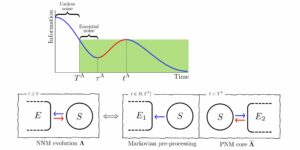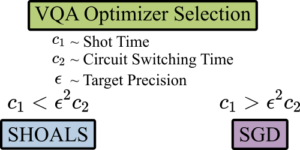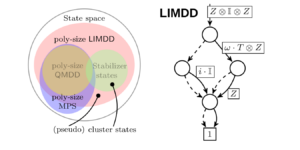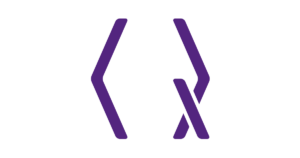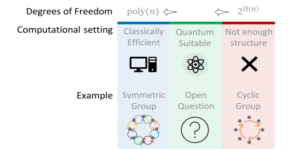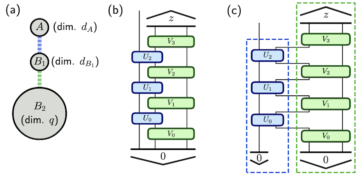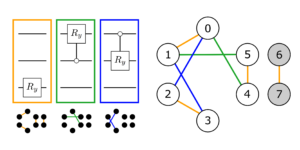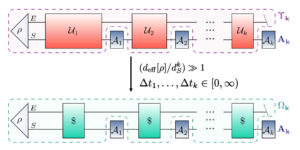1Department of Mathematics, Duke University, Durham, NC 27708, USA
2Department of Electrical and Computer Engineering, Department of Computer Science, Duke University, NC 27708, USA
Find this paper interesting or want to discuss? Scite or leave a comment on SciRate.
Abstract
The challenge of quantum computing is to combine error resilience with universal computation. Diagonal gates such as the transversal $T$ gate play an important role in implementing a universal set of quantum operations. This paper introduces a framework that describes the process of preparing a code state, applying a diagonal physical gate, measuring a code syndrome, and applying a Pauli correction that may depend on the measured syndrome (the average logical channel induced by an arbitrary diagonal gate). It focuses on CSS codes, and describes the interaction of code states and physical gates in terms of generator coefficients determined by the induced logical operator. The interaction of code states and diagonal gates depends very strongly on the signs of $Z$-stabilizers in the CSS code, and the proposed generator coefficient framework explicitly includes this degree of freedom. The paper derives necessary and sufficient conditions for an arbitrary diagonal gate to preserve the code space of a stabilizer code, and provides an explicit expression of the induced logical operator. When the diagonal gate is a quadratic form diagonal gate (introduced by Rengaswamy et al.), the conditions can be expressed in terms of divisibility of weights in the two classical codes that determine the CSS code. These codes find application in magic state distillation and elsewhere. When all the signs are positive, the paper characterizes all possible CSS codes, invariant under transversal $Z$-rotation through $pi/2^l$, that are constructed from classical Reed-Muller codes by deriving the necessary and sufficient constraints on $l$. The generator coefficient framework extends to arbitrary stabilizer codes but there is nothing to be gained by considering the more general class of non-degenerate stabilizer codes.
Popular summary
We have derived necessary and sufficient conditions for a diagonal gate to preserve the code space of a CSS code and have provided an explicit expression of its induced logical operator. When the diagonal gate is a transversal $Z$-rotation through an angle $theta$, we derived a simple global condition that can be expressed in terms of divisibility of weights in the two classical codes that determine the CSS code. When all signs in the CSS code are positive, we have proved the necessary and sufficient conditions for Reed-Muller component codes to construct families of CSS codes invariant under transversal $Z$-rotation through $pi/2^l$ for some integer $l$.
The generator coefficient framework provides a tool to analyze the evolution under any given diagonal gate of stabilizer codes with arbitrary signs, and helps to characterize more possible CSS codes can be used in magic state distillation.
► BibTeX data
► References
[1] Jonas T. Anderson and Tomas Jochym-O’Connor. Classification of transversal gates in qubit stabilizer codes. Quantum Info. Comput., 16(9–10):771–802, Jul 2016. doi:10.26421/qic16.9-10-3.
https://doi.org/10.26421/qic16.9-10-3
[2] Hussain Anwar, Earl T. Campbell, and Dan E Browne. Qutrit magic state distillation. New J. Phys., 14(6):063006, 2012. doi:10.1088/1367-2630/14/6/063006.
https://doi.org/10.1088/1367-2630/14/6/063006
[3] James Ax. Zeroes of polynomials over finite fields. Am. J. Math., 86(2):255–261, 1964. doi:10.2307/2373163.
https://doi.org/10.2307/2373163
[4] Salman Beigi and Peter W Shor. $mathcal{C}_3$, semi-Clifford and generalized semi-Clifford operations. Quantum Inf. Comput., 10(1&2), 2010. doi:10.26421/QIC10.1-2-4.
https://doi.org/10.26421/QIC10.1-2-4
[5] Ingemar Bengtsson, Kate Blanchfield, Earl T. Campbell, and Mark Howard. Order 3 symmetry in the Clifford hierarchy. J. Phys. A Math. Theor., 47(45):455302, 2014. doi:10.1088/1751-8113/47/45/455302.
https://doi.org/10.1088/1751-8113/47/45/455302
[6] Yuri L. Borissov. On Mceliece’s result about divisibility of the weights in the binary Reed-Muller codes. In Seventh International Workshop, Optimal Codes and related topics, pages 47–52, 2013. URL: http://www.moi.math.bas.bg/oc2013/a7.pdf.
http://www.moi.math.bas.bg/oc2013/a7.pdf
[7] P. Oscar Boykin, Tal Mor, Matthew Pulver, Vwani Roychowdhury, and Farrokh Vatan. On universal and fault-tolerant quantum computing: a novel basis and a new constructive proof of universality for shor’s basis. In 40th Annu. Symp. Found. Comput. Sci. (Cat. No.99CB37039), pages 486–494. IEEE, 1999. doi:10.1109/sffcs.1999.814621.
https://doi.org/10.1109/sffcs.1999.814621
[8] Sergey Bravyi, Matthias Englbrecht, Robert König, and Nolan Peard. Correcting coherent errors with surface codes. Npj Quantum Inf., 4(1):1–6, 2018. doi:10.1038/s41534-018-0106-y.
https://doi.org/10.1038/s41534-018-0106-y
[9] Sergey Bravyi and Jeongwan Haah. Magic-state distillation with low overhead. Phys. Rev. A, 86(5):052329, 2012. doi:10.1103/physreva.86.052329.
https://doi.org/10.1103/physreva.86.052329
[10] Sergey Bravyi and Alexei Kitaev. Universal quantum computation with ideal Clifford gates and noisy ancillas. Phys. Rev. A, 71(2):022316, 2005. doi:10.1103/physreva.71.022316.
https://doi.org/10.1103/physreva.71.022316
[11] Robert A. Calderbank, Eric M. Rains, Peter W. Shor, and Neil J.A. Sloane. Quantum error correction via codes over ${GF}$(4). IEEE Trans. Inf. Theory, 44(4):1369–1387, 1998. doi:10.1109/isit.1997.613213.
https://doi.org/10.1109/isit.1997.613213
[12] Robert A. Calderbank and Peter W. Shor. Good quantum error-correcting codes exist. Phys. Rev. A, 54:1098–1105, Aug 1996. doi:10.1103/physreva.54.1098.
https://doi.org/10.1103/physreva.54.1098
[13] Earl T. Campbell, Hussain Anwar, and Dan E Browne. Magic-state distillation in all prime dimensions using quantum Reed-Muller codes. Phys. Rev. X, 2(4):041021, 2012. doi:10.1103/physrevx.2.041021.
https://doi.org/10.1103/physrevx.2.041021
[14] Earl T. Campbell and Mark Howard. Unified framework for magic state distillation and multiqubit gate synthesis with reduced resource cost. Phys. Rev. A, 95(2):022316, 2017. doi:10.1103/physreva.95.022316.
https://doi.org/10.1103/physreva.95.022316
[15] Shawn X. Cui, Daniel Gottesman, and Anirudh Krishna. Diagonal gates in the Clifford hierarchy. Phys. Rev. A, 95(1):012329, 2017. doi:10.1103/physreva.95.012329.
https://doi.org/10.1103/physreva.95.012329
[16] Dripto M. Debroy, Laird Egan, Crystal Noel, Andrew Risinger, Daiwei Zhu, Debopriyo Biswas, Marko Cetina, Chris Monroe, and Kenneth R. Brown. Optimizing stabilizer parities for improved logical qubit memories. Phys. Rev. Lett., 127(24), Dec 2021. doi:10.1103/physrevlett.127.240501.
https://doi.org/10.1103/physrevlett.127.240501
[17] Bryan Eastin and Emanuel Knill. Restrictions on transversal encoded quantum gate sets. Phys. Rev. Lett., 102(11):110502, 2009. doi:10.1103/physrevlett.102.110502.
https://doi.org/10.1103/physrevlett.102.110502
[18] Daniel Gottesman. Stabilizer codes and quantum error correction. California Institute of Technology, 1997. doi:10.48550/arXiv.quant-ph/9705052.
https://doi.org/10.48550/arXiv.quant-ph/9705052
arXiv:quant-ph/9705052
[19] Daniel Gottesman. The heisenberg representation of quantum computers. arXiv preprint quant-ph/9807006, 1998. doi:10.48550/arXiv.quant-ph/9807006.
https://doi.org/10.48550/arXiv.quant-ph/9807006
arXiv:quant-ph/9807006
[20] Daniel Gottesman and Isaac L. Chuang. Demonstrating the viability of universal quantum computation using teleportation and single-qubit operations. Nature, 402(6760):390–393, 1999. doi:10.1038/46503.
https://doi.org/10.1038/46503
[21] Jeongwan Haah. Towers of generalized divisible quantum codes. Phys. Rev. A, 97(4):042327, 2018. doi:10.1103/physreva.97.042327.
https://doi.org/10.1103/physreva.97.042327
[22] Jeongwan Haah and Matthew B. Hastings. Codes and protocols for distilling $ t $, controlled-$ s $, and toffoli gates. Quantum, 2:71, 2018. doi:10.22331/q-2018-06-07-71.
https://doi.org/10.22331/q-2018-06-07-71
[23] Jingzhen Hu, Qingzhong Liang, Narayanan Rengaswamy, and Robert Calderbank. Mitigating coherent noise by balancing weight-$2$ $Z$-stabilizers. IEEE Trans. Inf. Theory, 68(3):1795–1808, 2022. doi:10.1109/tit.2021.3130155.
https://doi.org/10.1109/tit.2021.3130155
[24] Emanuel Knill, Raymond Laflamme, and Wojciech Zurek. Accuracy threshold for quantum computation. arXiv quant-ph/9610011, 1996. doi:10.48550/arXiv.quant-ph/9610011.
https://doi.org/10.48550/arXiv.quant-ph/9610011
arXiv:quant-ph/9610011
[25] Anirudh Krishna and Jean-Pierre Tillich. Towards low overhead magic state distillation. Phys. Rev. Lett., 123(7):070507, 2019. doi:10.1103/physrevlett.123.070507.
https://doi.org/10.1103/physrevlett.123.070507
[26] Andrew J. Landahl and Chris Cesare. Complex instruction set computing architecture for performing accurate quantum $ z $ rotations with less magic. arXiv preprint arXiv:1302.3240, 2013. doi:10.48550/arXiv.1302.3240.
https://doi.org/10.48550/arXiv.1302.3240
arXiv:1302.3240
[27] Florence J. MacWilliams. A theorem on the distribution of weights in a systematic code. Bell Labs Tech. J., 42(1):79–94, January 1963. doi:10.1002/j.1538-7305.1963.tb04003.x.
https://doi.org/10.1002/j.1538-7305.1963.tb04003.x
[28] Florence J. MacWilliams and Neil J. A. Sloane. The theory of error correcting codes, volume 16. Elsevier, 1977.
[29] Robert J. McEliece. On periodic sequences from GF($q$). J. Comb. Theory Ser. A., 10(1):80–91, 1971. doi:10.1016/0097-3165(71)90066-5.
https://doi.org/10.1016/0097-3165(71)90066-5
[30] Robert J. McEliece. Weight congruences for p-ary cyclic codes. Discrete Math, 3(1):177–192, 1972. doi:10.1016/0012-365X(72)90032-5.
https://doi.org/10.1016/0012-365X(72)90032-5
[31] Sepehr Nezami and Jeongwan Haah. Classification of small triorthogonal codes. Phys. Rev. A, 106:012437, Jul 2022. doi:10.1103/PhysRevA.106.012437.
https://doi.org/10.1103/PhysRevA.106.012437
[32] Michael A. Nielsen and Isaac L. Chuang. Quantum Computation and Quantum Information: 10th Anniversary Edition. Cambridge University Press, 2011.
[33] Tefjol Pllaha, Narayanan Rengaswamy, Olav Tirkkonen, and Robert A. Calderbank. Un-weyl-ing the Clifford hierarchy. Quantum, 4:370, 2020. doi:10.22331/q-2020-12-11-370.
https://doi.org/10.22331/q-2020-12-11-370
[34] Ben W. Reichardt. Quantum universality from magic states distillation applied to css codes. Quantum Inf. Process., 4(3):251–264, 2005. doi:10.1007/s11128-005-7654-8.
https://doi.org/10.1007/s11128-005-7654-8
[35] Narayanan Rengaswamy, Robert A. Calderbank, Michael Newman, and Henry D. Pfister. On optimality of CSS codes for transversal $T$. IEEE J. Sel. Areas in Inf. Theory, 1(2):499–514, 2020. doi:10.1109/jsait.2020.3012914.
https://doi.org/10.1109/jsait.2020.3012914
[36] Narayanan Rengaswamy, Robert A. Calderbank, and Henry D. Pfister. Unifying the Clifford hierarchy via symmetric matrices over rings. Phys. Rev. A, 100(2):022304, 2019. doi:10.1103/physreva.100.022304.
https://doi.org/10.1103/physreva.100.022304
[37] A. M. Steane. Simple quantum error-correcting codes. Phys. Rev. A, 54(6):4741–4751, 1996. doi:10.1103/PhysRevA.54.4741.
https://doi.org/10.1103/PhysRevA.54.4741
[38] Michael Vasmer and Aleksander Kubica. Morphing quantum codes. PRX Quantum, 3(3), Aug 2022. doi:10.1103/prxquantum.3.030319.
https://doi.org/10.1103/prxquantum.3.030319
[39] Christophe Vuillot and Nikolas P. Breuckmann. Quantum pin codes. IEEE Trans. Inf. Theory, 68(9):5955–5974, Sep 2022. doi:10.1109/tit.2022.3170846.
https://doi.org/10.1109/tit.2022.3170846
[40] Mark M Wilde. Quantum information theory. Cambridge University Press, 2013.
[41] Paolo Zanardi and Mario Rasetti. Noiseless quantum codes. Phys. Rev. Lett., 79(17):3306, 1997. doi:10.1103/PhysRevLett.79.3306.
https://doi.org/10.1103/PhysRevLett.79.3306
[42] Bei Zeng, Xie Chen, and Isaac L. Chuang. Semi-Clifford operations, structure of $mathcal{C}_k$ hierarchy, and gate complexity for fault-tolerant quantum computation. Phys. Rev. A, 77(4):042313, 2008. doi:10.1103/physreva.77.042313.
https://doi.org/10.1103/physreva.77.042313
[43] Bei Zeng, Andrew Cross, and Isaac L. Chuang. Transversality versus universality for additive quantum codes. IEEE Trans. Inf. Theory, 57(9):6272–6284, 2011. doi:10.1109/tit.2011.2161917.
https://doi.org/10.1109/tit.2011.2161917
Cited by
[1] Jingzhen Hu, Qingzhong Liang, Narayanan Rengaswamy, and Robert Calderbank, “Mitigating Coherent Noise by Balancing Weight-2 $Z$-Stabilizers”, arXiv:2011.00197.
[2] Jingzhen Hu, Qingzhong Liang, and Robert Calderbank, “Climbing the Diagonal Clifford Hierarchy”, arXiv:2110.11923.
[3] Jingzhen Hu, Qingzhong Liang, and Robert Calderbank, “Divisible Codes for Quantum Computation”, arXiv:2204.13176.
The above citations are from SAO/NASA ADS (last updated successfully 2022-09-08 15:11:47). The list may be incomplete as not all publishers provide suitable and complete citation data.
Could not fetch Crossref cited-by data during last attempt 2022-09-08 15:11:45: Could not fetch cited-by data for 10.22331/q-2022-09-08-802 from Crossref. This is normal if the DOI was registered recently.
This Paper is published in Quantum under the Creative Commons Attribution 4.0 International (CC BY 4.0) license. Copyright remains with the original copyright holders such as the authors or their institutions.


